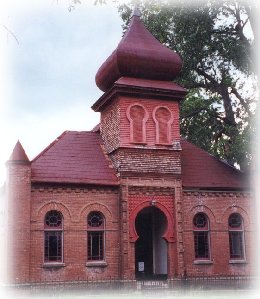
|
Traveling northeast out of Natchez on the historic and scenic Natchez Trace Parkway, the drive to Port Gibson follows the route used by tradesmen from Tennessee and Kentucky who, in the early 1800's, floated their trade goods down the Mississippi River on barges and then returned home on foot via the old Indian trail known as the Natchez Trace. 
A Jewish community no longer exists in Port Gibson, but it was once home to fifty Jewish families, most of whom worked as merchants and cotton brokers. Several buildings located in the downtown area bear the names of Jewish merchants of those earlier days.  The real focus of Port Gibson's Jewish past is Temple Gemiluth Chassed, of Byzantine and Moorish style, built in 1891. It is the oldest surviving synagogue in Mississippi and the only known example of that architectural style in the State. The once-beautiful Temple Gemiluth Chassed is now closed and in disrepair.  The Jewish Cemetery in Port Gibson opened in 1870. Prior to that time, the Jews of Port Gibson were buried in Natchez. The cemetery is gated and locked, making it difficult to read names on the stones. One, located near the gate, was inscribed Julia Kauffmann, nee Klotz, born in Soultz-Sous-Foret, Alsace on August 20, 1847, died May 28, 1912. [Sources for some of the information above: website and brochures published by the Museum of the Southern Jewish Experience in Utica, Mississippi.] |
